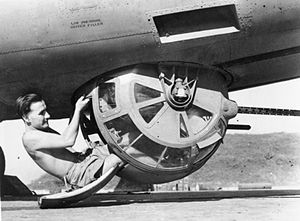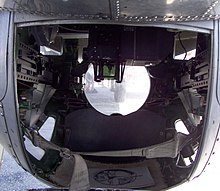Ball turret
| Ball Turret | |
|---|---|
 A crewman poses with the Sperry ball turret of a Royal Air Force B-24, Burma, c.1943-1945 | |
| Service history | |
| Used by | United States, United Kingdom, China |
| Wars | World War II |
| Specifications | |
| Caliber | .50 BMG |
A ball turret is a spherical-shaped,
It was a manned turret, as distinct from remote-controlled turrets also in use.
Sperry ball turret

This section possibly contains original research. (July 2016) |
Sperry and
The Sperry ball turret was 3 and a half feet in diameter in order to reduce drag, and was typically operated by the smallest man of the crew. To enter the turret, the turret was moved until the guns were pointed straight down. The gunner placed his feet in the heel rests and occupied his cramped station. He would put on a safety strap and close and lock the turret door. There was no room inside for a parachute, which was left in the cabin above the turret. The Ball Turret Gunner was the only man of the crew to not have a parachute on or next to him.
The gunner was forced to assume a

In the case of the B-24, the Liberator's tricycle landing gear design mandated that its A-13 model Sperry ball turret have a vertically retractable mount, so that the turret would not strike the ground as the plane pitches up for takeoff or during the landing flare. The conventional landing gear of the B-17 allowed for a non-retractable mount, but if the plane was required to do a belly landing (such as in the case of landing gear system failure), the ball turret would likely be destroyed due to the lack of clearance, meaning anyone occupying the turret would be in a precarious position if unable to escape.
ERCO ball turret
See also
References
- ^ Aircraft Fire Control. Great Neck, New York: Sperry Gyroscope Company. Retrieved 26 May 2020.
- ^ Holley, Irving B. Jr. (June 1947). Development of Aircraft Gun Turrets in the AAF, 1917-1944 (Report). Army Air Forces Historical Studies. AAF Historical Office, Headquarters, Army Air Forces. Archived from the original on May 21, 2020. Retrieved 26 May 2020.
- ^ "My Dad Was A Ball Turret Gunner In World War II". HuffPost. 2015-11-11. Retrieved 2022-06-16.
- ^ Aircrewman's Gunnery Manual. Aviation Training Division, Office of the Chief of Naval Operations. 1944. Retrieved 26 May 2020.

